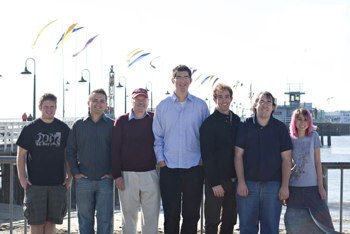Electricity-generating wind turbines may soon take their place alongside the fishermen and flagpoles on the Santa Cruz Municipal Wharf.
A team of enterprising UC Santa Cruz engineering students is laying the groundwork for this ambitious $1 million project, which would also include solar cells on Wharf roof tops and a tide-powered electricity-generating device.
If all goes well with a feasibility study, input from the public and university biologists, the Wharf could be 100 percent energy self-sufficient within the next three years, said engineering professor Michael Isaacson, an advisor to the green-wharf project.
Santa Cruzans are famous for being outspoken about environmental impacts and blocked views. For this reason, the project will be a good test case for those who wish to build renewable energy projects in other California coastal areas, said Isaacson, who has an "if we can make it there, we can make it anywhere'' philosophy about the project.
"The Wharf is embedded in a community that may be hostile toward doing anything new (at the wharf) so if we can figure out how to do such a project in the center of Santa Cruz it is something that could be transportable to other coastal communities such as Monterey and Santa Monica,'' Isaacson said.
"We want to find out what the community feels about this,'' Isaacson said. "We want to find out what they consider acceptable and unacceptable."
The senior engineering students, who call themselves the Green Wharf Team, plan to put sensors on the Wharf to measure potential energy from the water, air and sunlight.
"A lot of us are doing this in lieu of a written senior thesis because this is a lot more fun,'' project leader Brian Simmons said.
The Green Wharf group plans to put 700 pounds of equipment, including a single two-meter-tall wind turbine, on the roof of the Wharf headquarters building to study the effects of the coastal environment on the green-energy solar cells and machinery, and make sure the equipment does not harm wildlife.
But first the group must wait for the roofs to be redone on the Wharf headquarters this summer. And there are no guarantees that the project will work at the ½-mile-long, 96-year-old Wharf, a city landmark that is the second most highly visited tourist attraction in Santa Cruz County. There is some concern that the saline air will corrode the mechanisms and that local seagulls will splatter their droppings all over the solar panels.
To address this potential problem, the students have prepared a camera that will take photos of the solar panels. Camera details are still in the works, but the Green Wharf team hopes to snap one picture per hour.
"We're gathering data to determine whether a renewable power system would be viable on the Wharf or whether the wind turbines and solar panels would melt in the salty air,'' said team member Spencer Matteson.
City helps Wharf go green
The City of Santa Cruz has provided seed money for the Green Wharf Project and has collaborated on grant proposals. Read more »
Turbines and the Wharf might sound like a peculiar combination to green-minded Santa Cruz County residents who associate the word "turbine'' with the gigantic, three-pronged windmills in lonely places like Altamont Pass and the Tehachapi Valley. Such windmills can reach upwards of 300 feet, with exposed, rapidly spinning blades that can kill birds.
But the team members assure that the tester turbine will be a mere two meters tall, which is tiny compared to turbines in industrial wind farms.
"I don't think the Dream Inn would really appreciate having one of those things obstructing their view,'' Simmons said, referring to a popular hotel that is close to the Wharf and is best known for its ocean views.
Simmons said the team is considering a turbine designed by companies that claim their products are more 'bird proof' than horizontal-axis wind turbines. He said that these smaller versions would look more like "egg beaters" than windmills.
Manufacturers claim these turbines are more bird-safe "because they claim to present a nearly opaque surface so birds don't think they can fly through,'' Simmons said.



